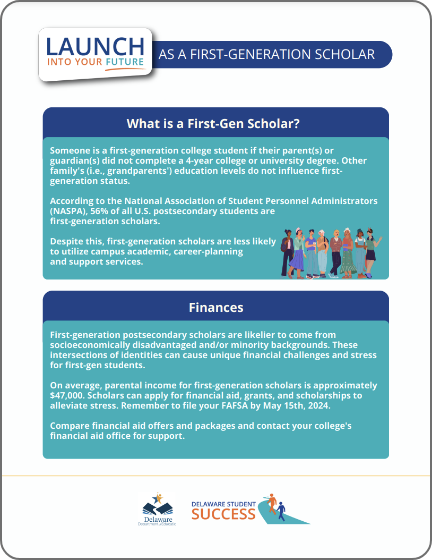Identify Your Colleges
After you have learned about the different types of colleges and how they are funded (see Types of Colleges), you’re ready to start creating a list of colleges. You should look for ones that match your interests and that you might want to apply to.

There are four main steps you should take to identify colleges of interest:

Researching potential colleges
Get organized: You can use our “Make Your College List” organizer to list colleges that match your preferences and needs. Two of the best online search tools are BigFuture and the College Scorecard. While you make this list, consider the following factors to help you personalize your research:
Personal fit
Use these factors to help you identify colleges that meet your preferences and needs.
Location: How close do you want to live to your home? Are you interested in living in a city, suburban, or rural area?
Distances:
2 miles (walking distance)
20 miles (short drive)
50 miles (moderate drive)
200 miles (long drive)
500 miles (short flight)
2000 miles (long flight)
Setting:
Urban (located in cities)
Suburban (in small cities, large towns, residential areas)
Rural (near farms, wilderness areas, in small town)
Time: How quickly do you want to earn your degree? If you wish to complete a degree in two years, explore community colleges. If you want to complete your degree in four years, explore four-year colleges and universities.

Campus size: Would you prefer a small, medium, or large student body?
Small: Less than 5,000 students
Medium: Between 5,000 and 15,000 students
Large: More than 15,000 students
Class size: While many students consider the total size of a college, the average class size can be a more critical factor. Across all college sizes, it is common for large class sizes (such as in a lecture hall) in the first few semesters and smaller class sizes later in college when you take high-level, major-specific courses.
Clubs or student organizations: Are there clubs and groups that match your interests (e.g., dance, student-run radio station or newspaper, student government, social, cultural, co-curricular or honors fraternity or sorority)?
Housing opportunities: Colleges offer different housing options, from dormitories to apartment buildings. Learn what each college offers and decide if it matches your needs. Do you want to share a room? Would you prefer a suite? What about gender-specific dorms?
Study abroad: If you are interested in studying abroad, research what types of options are available at each college. Typically, study abroad opportunities are additional costs beyond the college’s tuition it is important to see if there is any financial aid offered by the college.
Diversity: Does the student population at the college meet your needs? Since diversity is measured in many ways, it is important to visit the college’s website to learn more about the student population. You can learn more about Minority Serving Institutions and HBCUs here.
Athletics: Does the college offer the athletic opportunities you are interested in? Click here to learn more about playing sports in college through a club or team.
Disability support services: What type of support and services are offered for students with disabilities? Click here to learn more about these services and requesting accommodations in college.
 First generation scholars support: What types of support are available for students who are the first to attend college in their families?
First generation scholars support: What types of support are available for students who are the first to attend college in their families?

Academic fit
Use the following to help you decide which colleges match your learning needs and academic ability:
Acceptance rate/selectivity: How competitive is being accepted into the college? Is your academic, athletic or artistic performance strong enough to be accepted?
Most selective (0 to 10% accepted)
Very selective (10 to 25% accepted)
Selective (25 to 50% accepted)
Less selective (50 to 90% accepted)
Not selective (90 to 100% accepted)
Majors: Do the majors and minors offered match your career interests? A major is a specific subject area that you will focus on. Up to half of your coursework will be in or related to your major. Your major should directly relate to your career path (e.g., if you want to become a nurse, you should major in nursing).
Minors: A minor is a secondary area of study that complements your major and allows you to explore another area that will support your career goals or explore a passion or hobby.

Academic supports: What supports does the college offer to help you succeed (libraries, tutoring, academic advising, writing centers, etc.)?
Early college credit transfer: Which colleges will accept the early college credit(s) that you earned in high school through Advanced Placement, dual enrollment, or International Baccalaureate? You can learn more here.

Career fit
Use the following to help you determine which college and programs will best prepare you for your future career.
Major to career: Does the major match your future career interest? Search the U.S. Department of Labor’s Occupational Outlook Handbook to see the recommended majors or educational pathways that align with that career.
Graduation and retention rates: These measure how successful the college is at its initial purpose: retaining and graduating students. Higher rates can show that a college has strong success in supporting students academically and socially and has strong financial support systems for most students.
Graduation rate: This is the percentage of students who complete their degree on time, typically in 4-6 years. A high graduation rate indicates that the college successfully supports its students in completing their degrees and achieving their educational goals, especially for students who share similar identities. Search for colleges above the national graduation rate average of 64%.
Retention rate: This is the percentage of first-year students who return to the same college for their sophomore year. It can be used to measure how well a college supports students academically and socially. Search for colleges above the national retention rate average of 77%.
Hint: Look at the graduation and retention rates for students who share your identity — race, ethnicity, first-generation college status, or other factors. This can give you insight into how well the college supports students with similar backgrounds to yours.

Creative portfolios, prescreens, and auditions: For music and visual and performing arts programs, you will usually have to submit a creative portfolio or participate in a prescreen or audition process. It is important to identify portfolio or audition requirements early in your research process since these requirements are often time-consuming and demanding as a part of your review.
Hint: Check out “National Portfolio Day” and meet with counselors, admission team members, and faculty from accredited art and design colleges worldwide for free portfolio reviews.
Career services: What tools does the college offer to help you plan a career and secure employment? Does the college have relevant internship experiences in your career field of interest? How strong is the college’s job placement rate, a measurement of how many graduates are employed in the careers they were trained for?

Financial fit
Knowing which colleges are a good financial fit for your budget is essential to minimize financial hardship while maximizing your future goals. In the event that you need to take out a student loan, you need to identify colleges where this amount will not be a financial burden and that you will be able to pay back the loan in a reasonable amount of time.
Cost: Does the cost of college and the amount of financial aid the average student receives match your financial budget? Be careful when reviewing the “sticker price” of a college. This is the published tuition cost. Students often pay less than a college’s listed sticker price because most colleges offer financial aid. The actual amount a student ends up paying is called the “net price” or “out-of-pocket cost. Determining how much you will actually pay can be challenging, but students can get some insight by using these tools.
BigFuture >
Allows you to filter colleges by the financial need you will need. This is listed as a percentage of a student’s financial need that a college will likely cover with financial aid.
The College Scorecard >
See the average cost of attendance at each college based on your family income.
U.S. Dept of Education’s Net Price Calculator Center >
Provides links to colleges’ net price calculators. Net price calculators help you estimate colleges’ costs after scholarships and grants.
TuitionFit >
Helps you to find colleges in your price range. You can also upgrade to see the details of each financial aid offer.

Average debt upon graduation: What will it cost to get an education? Will your prospective career path make it feasible to repay your student loans?


Campus visits and college fairs 
While researching colleges and making their college lists, you should visit college campuses and attend college fairs.
Identify which colleges are a “best fit”
Once you have created your personalized college list, we recommend determining which colleges are a “best fit” for you to have a balanced list of 8-10 colleges when it is time to apply. You should compare your interests, academic record, and standardized test scores against the average admitted student to help determine if the college is an undermatch, match, or overmatched.
Undermatched
College that you will almost certainly get into because your GPA, test scores (ACT/SAT), and/or class rank are well above the college’s average (typically top 25%).
✓ Frequently called Safety Schools
✓ Most likely to be accepted
✓ Students should apply to 2-3 of these colleges
Matched
College that you are likely to get into because your GPA, test scores, or class rank fall into the college’s middle range of admitted students (you are higher than the bottom 25% of students but lower than the top 25% of students)
Overmatched
College where your GPA, test scores, and class rank typically put you in the college’s bottom 25% of students. But with very good recommendations, an excellent essay or a one-on-one interview with an admissions representative, you might be able to get into these colleges.
✓ Frequently called Reach Schools
✓ Least likely to be accepted
✓ Students should apply to 1-2 of these colleges
What’s next?
After creating your balanced college list, you can begin applying to your 8-10 colleges in the fall of your senior year.




